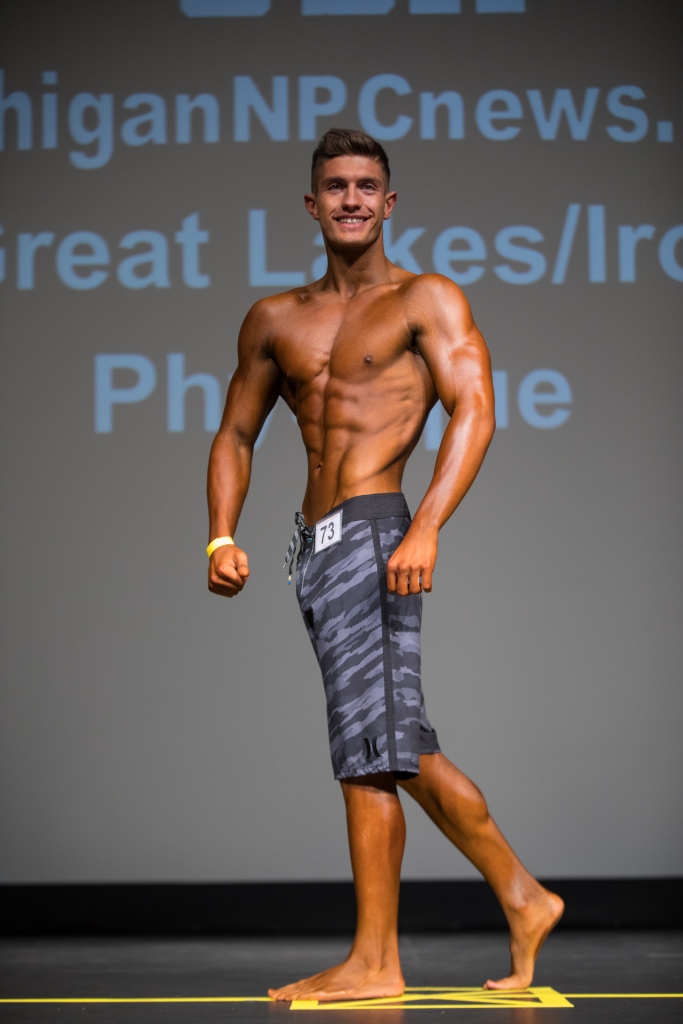
What Makes A Mens Physique Athlete?
- Wide, Pronounced V-Taper With Relaxed Posture
- Small Tapered Waistline
- Muscular, Balanced Deltoids
- Clearly defined abdominals
- Symmetrical Upper Arms And Calves
- Muscular Pronounced Chest
- Overall Balanced Muscular Symmetry
What About Legs?
Notice, even though there is no emphasis on the development of the legs, they are vital to a complete physique. You are only as strong as your weakest link, aside from the aesthetic importance of leg training, lots of everyday movements and pains stem from poor posture, weak legs and lack of core control can be lessened/improved with stronger glutes, hamstrings, quadriceps, calves, hip flexors/abductors and lower abdominals. So make sure you can jump, squat, kneel, step, throw and crawl with strength and mobility no matter what your goals are.
How does a novice men’s physique athlete train?
It depends! experience, recovery time, equipment accessibility, injuries and availability are all determining factors. Novice competitors will still require an emphasis on strength training in the basic horizontal press, vertical press, hinge and squat just as every trainee. Whilst utilizing most bicep work to chin ups and rows and tricep work to dips and close grip presses all the while maintaining healthy function in their lumbar, scapula, lunge pattern, carry and most importantly core/abdominal fitness. This allows for a much broader and safer workbench to use while developing their physique to a champion level. Brand new trainees with little to no experience will get enough volume from a mixture of these compound exercises and their variations that stimulate all of the major musculature with most assistance work directed to the supporting musculature multiple times per week according to Crewther et al (2015) who compared x3 full body weekly workouts against x2 per week upper lower split routine and found 0.7% more muscle growth in the whole body/higher frequency group. However, more advanced trainees that may have already built a broad and respectable workbench of strength given they have been consistent may require a heavier emphasis on variations of the same compound lifts and assistance work as a shift to symmetry is now a larger concern than it was before they had established such a sturdy and broad foundation. These trainees may find that splitting these workouts across 4-5 day periods more manageable. In regards to strength, these trainees should not neglect one form of training over the other, B. Schoenfeld et al (2016) showed us that 8-12RM and 1-4RM training is equally beneficial in terms of hypertrophy. If a trainee is doing low-rep, heavy strength work (80%1RM) in the beginning of the week or block, it may be beneficial for them to end the week or block with lighter weight, higher-rep (30%1RM) training.
How does a novice men’s physique athlete eat?
Eating is crucial to the physique athlete of any level, to represent a tapered waistline and lean defined abdominals, trainees aspiring to look like these athlete’s should be conscientious of their bodyfat levels throughout the year, they’re never heavier than 15 pounds above stage weight! one doesn’t need prohormones to maintain this level of leanness contrary to belief. Simply just staying within a positive or negative 400 calorie range of a trainees BMR should make maintaining body composition much, much easier.. The biggest mystery is still how much should trainees eat? For simplicity’s sake, one of the most tried and true ways to solve this is with the Revised Harris Benedict Method, according to S. Lee et al.(2012) out of the 12 formulas used to estimate RMRs, their study revealed that the Harris-Benedict’s formula was the most accurate.
The formula looks like this; 66.5 + (13.75 x kg) + (5.003 x cm) – (6.775 x age) = BMR
Or use this calculator.
Basal Metabolic Rate (BMR) and Daily Calorie Needs – Calculator Online (Harris-Benedict equation)Determining specific macro targets (protein, carbs, fat) is a hot topic for debate. Trainees may hear of a friend getting absolutely ripped off of the keto diet, meanwhile their other friend is more or just as ripped eating a high carb and low fat diet. This causing lots of confusion and lots of junk information floating around the internet, both methods will work depending on the individual. No way of eating is going to be more superior for muscle growth and leanness than the one you enjoy and find the most realistic to stick to in the long term. However once again for the sake of simplicity ,we advise trainees who are new to logging and calculating calories to consume 1 gram of protein per pound of bodyweight, 1/2 their body weight in grams of fat, and the remainder of the days calories will go to carbohydrates.
Have Part 2 Automatically Sent To You Here!
